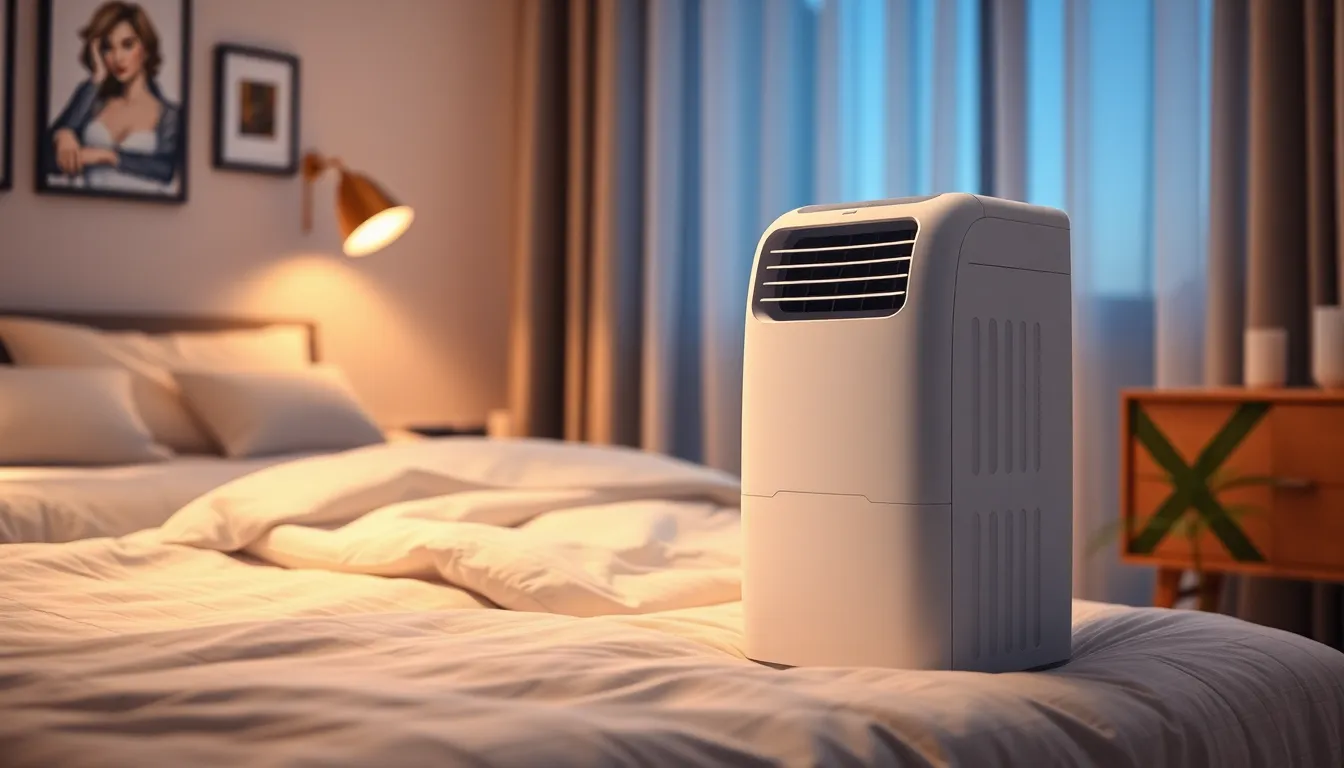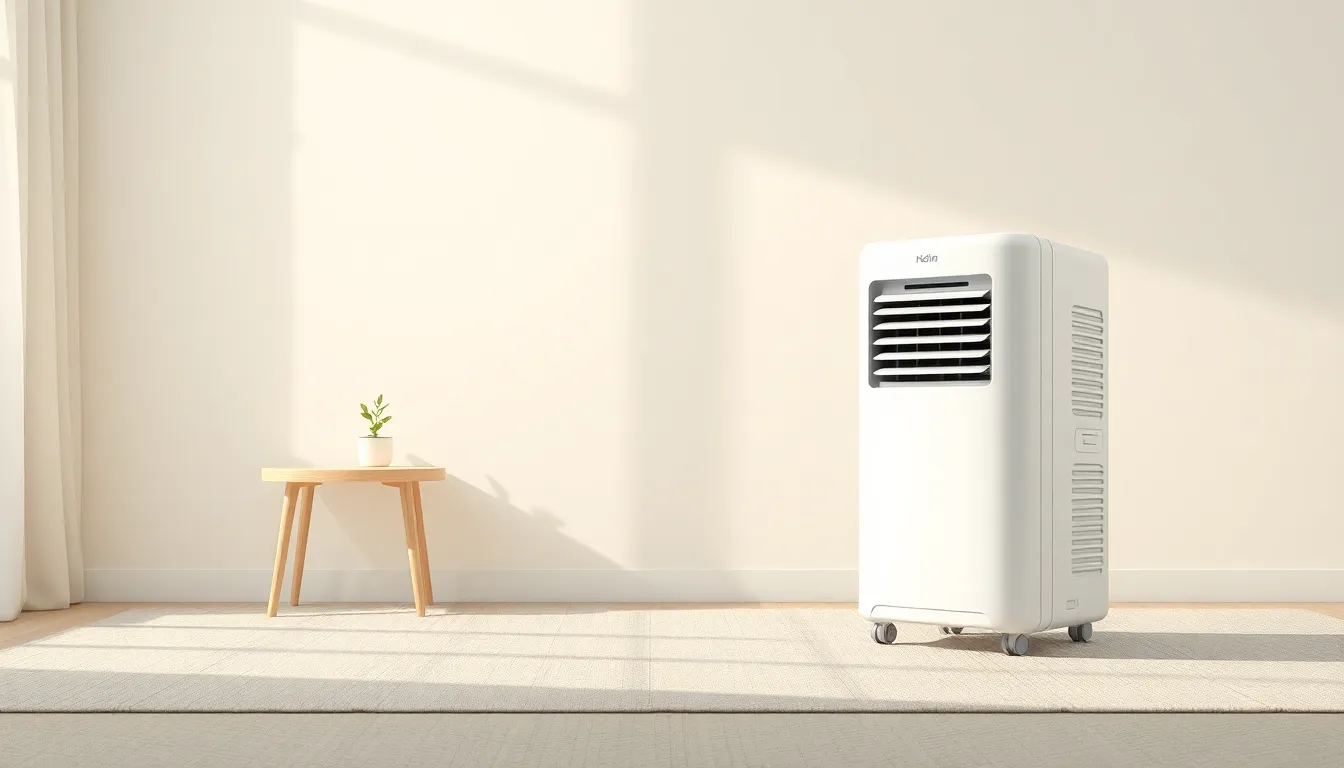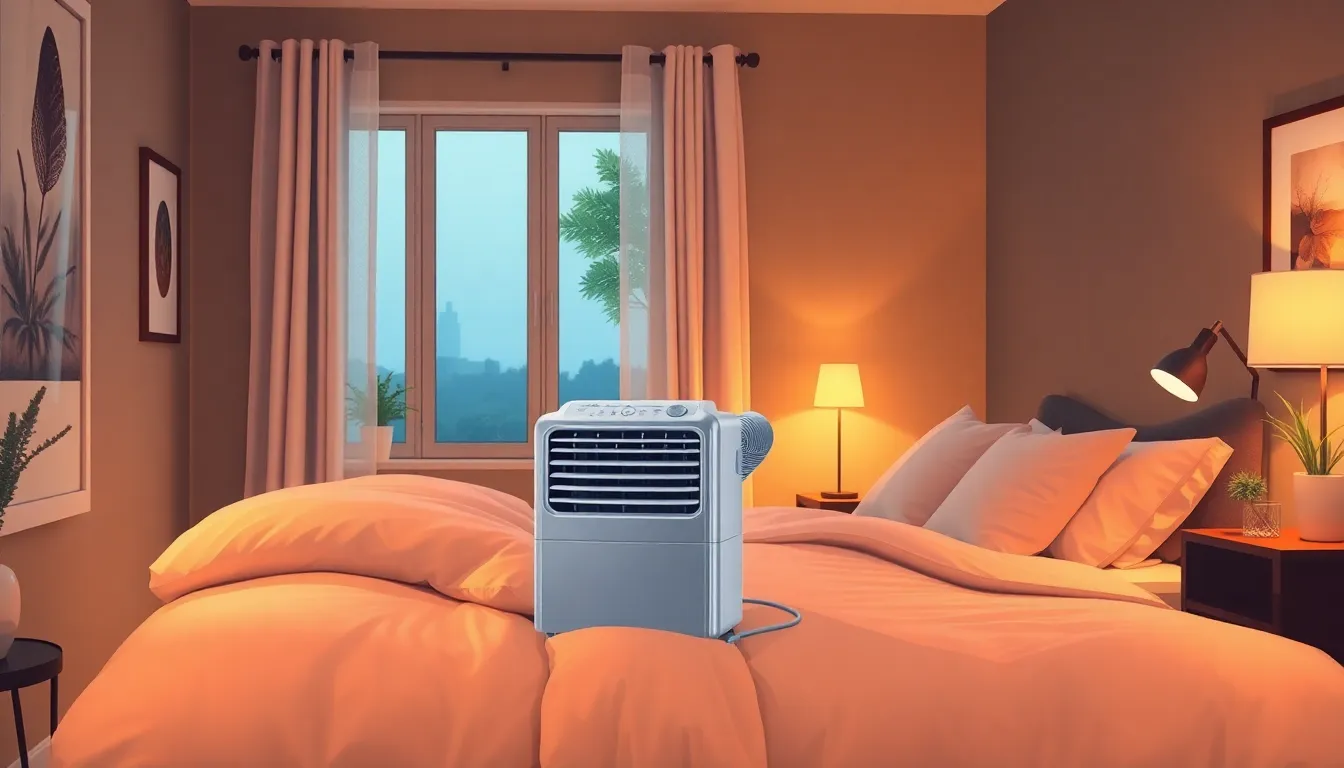When summer hits and the heat turns your bedroom into a sauna, it’s time to rethink your cooling strategy. Portable air conditioners are the unsung heroes of hot nights, offering a refreshing breeze without the commitment of a permanent unit. Imagine drifting off to sleep in a cool cocoon while the outside world swelters. Sounds dreamy, right?
Table of Contents
ToggleOverview Of Portable Air Conditioners
Portable air conditioners offer versatility and convenience for cooling small spaces. Compact units allow easy movement from room to room, targeting areas with the highest need for temperature control. Various models include features like adjustable thermostats, remote controls, and programmable timers, enhancing user experience. Energy efficiency ratings vary, with many units designed to consume less electricity while still providing effective cooling.
Cooling capacity typically ranges from 8,000 to 14,000 BTUs, suitable for different room sizes. Smaller units effectively cool spaces up to 300 square feet, while larger models handle areas up to 600 square feet. Additional features such as dehumidification enhance performance by removing excess moisture from the air, improving comfort levels.
Noise levels depend on the model, with quieter units designed for minimal disturbance during sleep. Popular brands often offer multiple noise level settings, allowing users to select their preferred comfort level. Installation remains straightforward, requiring no permanent changes to home structures, as these units use flexible exhaust hoses vented through windows.
Portable air conditioners can also provide heating functions, making them versatile year-round solutions. Modern designs incorporate aesthetic elements, blending seamlessly into home decor. Overall, these units offer a practical solution for maintaining a comfortable bedroom environment during hot summer nights.
Key Features To Consider


Choosing the right portable air conditioner for a bedroom involves understanding essential features that enhance performance and comfort.
Cooling Capacity
Cooling capacity directly influences how effectively a unit can lower room temperature. Models range from 8,000 to 14,000 BTUs, accommodating various room sizes. For example, an 8,000 BTU unit suits spaces up to 300 square feet, while a 12,000 BTU model can chill areas up to 400 square feet. Selecting the appropriate capacity ensures optimal cooling. If the space is significantly larger than the unit’s capabilities, cooling may be inadequate. Hence, assessing room dimensions is critical when selecting a portable AC.
Noise Level
Noise levels impact comfort, especially during sleep. Most portable air conditioners emit noise levels ranging from 50 to 60 decibels. Quieter models operate below 50 decibels, offering an unobtrusive climate experience. Users looking for a peaceful night’s sleep should prioritize models marketed as “quiet” or “sleep-friendly.” Additionally, manufacturers often include decibel ratings in product specifications, aiding informed decisions. Ensuring the chosen model operates silently enhances the sleeping environment.
Energy Efficiency
Energy efficiency defines how economically a portable AC operates. Units often feature Energy Efficiency Ratios (EER) between 8 and 12, affecting electricity consumption. Higher EER ratings indicate more efficient cooling, leading to lower energy bills. Many models also carry Energy Star certifications, ensuring adherence to strict efficiency guidelines. Shoppers should examine these ratings to choose energy-efficient options. Opting for such units minimizes environmental impact while maximizing comfort.
Top Picks For Best Portable AC For Bedroom
These selected models excel in providing optimal cooling while maintaining comfort in a bedroom setting. Each unit highlights unique features and efficiency tailored for restful sleep during hot summer nights.
Model 1 Review
The Black+Decker BPACT08WT stands out with its 8,000 BTU cooling capacity. Designed for rooms up to 200 square feet, this unit efficiently cools while maintaining a noise level of only 53 decibels. Its user-friendly interface includes an LED display and remote control for easy adjustments. Additionally, the programmable timer allows for customized cooling schedules. Energy-efficient, it boasts an EER of 12.1, making it a cost-effective choice. Users appreciate its compact design, allowing for easy portability between spaces.
Model 2 Review
The Honeywell HL14CESWK offers a robust 14,000 BTU cooling output and serves larger spaces up to 600 square feet. Built with a dehumidification mode, this model effectively removes excess moisture, enhancing comfort. Operating at a noise level of 56 decibels, it remains relatively quiet during nighttime use. The unit features an energy saver mode along with an EER rating of 11.2, ensuring energy savings. Convenience is enhanced through easy installation with a compatible window venting kit, making setup quick and hassle-free.
Model 3 Review
The Whynter ARC-14SH combines cooling and heating capabilities with its dual functionality. With 14,000 BTUs, it effectively cools spaces up to 500 square feet while operating at a maximum noise level of 56 decibels. The dehumidifier function aids in maintaining dryness, alleviating discomfort on humid nights. An EER rating of 11.0 confirms its efficiency, keeping energy consumption low. This model also includes a programmable thermostat and a remote control, ensuring easy management of settings from anywhere in the room.
How To Choose The Right Portable AC
Selecting the right portable air conditioner involves several important factors. First, consider cooling capacity, with options ranging from 8,000 to 14,000 BTUs. Models within this range effectively cool spaces between 200 to 600 square feet, making them suitable for various bedroom sizes.
Noise levels matter, especially for sleep quality. Many units operate between 50 to 60 decibels. Quieter options, under 50 decibels, create a serene atmosphere perfect for restful nights.
Energy efficiency plays a crucial role in long-term cost savings. Look for Energy Efficiency Ratios (EER) between 8 and 12. Higher ratings signify lower energy bills, making smart choices essential for budget-conscious consumers. Energy Star certifications ensure compliance with efficiency standards.
Additional features can enhance user experience. Options like remote controls and programmable timers add convenience. Some units also offer dehumidification functions, which effectively remove excess moisture, further improving comfort.
Installation simplicity cannot be overlooked. Most portable air conditioners require no permanent modifications to your home. Flexible exhaust hoses vent through windows, ensuring an easy setup process.
Examine functionality possibilities. Certain models also provide heating capabilities, making them valuable throughout the year. Versatile options adapt to changing seasons, offering both cooling and heating as needed.
Budget constraints influence decision-making. Investing in a quality unit typically leads to better performance and durability. Careful research helps identify models that balance cost and functionality effectively.
Maintenance Tips For Portable AC Units
Regular upkeep ensures a portable AC unit operates efficiently. Cleaning or replacing filters every month keeps air flowing freely and improves air quality. Clogged filters can reduce cooling efficiency, resulting in higher energy bills.
Draining condensation is crucial for optimal performance. Most units include a drain pan, and emptying it prevents water buildup, which can lead to mold and unpleasant odors. Inspecting the drainage hose frequently helps avoid clogs.
Checking the exhaust hose installation enhances cooling efficiency. A properly installed hose directs hot air outside and prevents backflow inside the room. Ensure that it remains securely connected during operation.
Cleaning the exterior of the unit helps maintain its appearance and function. Dust and debris can accumulate, impacting cooling. Wiping down surfaces with a damp cloth keeps the unit looking clean.
Monitoring the temperature settings aligns comfort with energy efficiency. Setting the thermostat to a moderate level reduces energy consumption without sacrificing comfort. Even a few degrees can make a significant difference.
Inspecting the unit for any physical damage is advisable. Look for wear and tear on the hoses and connections. Reporting issues early can prevent more extensive repairs.
Lastly, consulting the user manual offers guidance specific to the model. Each portable AC unit may have unique maintenance requirements, ensuring the unit provides effective cooling for years to come. Adjusting maintenance practices based on manufacturer recommendations enhances durability.








